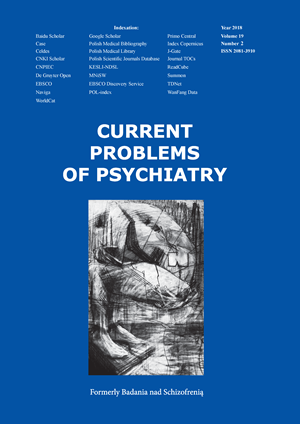A Psycholexical Classification of Ukrainian Descriptors of Individual Differences
DOI:
https://doi.org/10.2478/cpp-2018-0007Keywords:
individual differences, personality, psycholexical taxonomy, Ukrainian languageAbstract
The aim of the psycholexical study was to classify the terms describing individual differences in the Ukrainian language.
Method. To accomplish this objective, we analysed 220,000 entries included in a universal dictionary of Ukrainian and identified 20,024 terms – adjectives, participles, type-nouns, and attribute-nouns – used to describe human characteristics. The identified person-descriptive terms were classified by a team of five trained judges into 13 categories and subcategories. The judges’ taxonomic decisions were tested for validity and interjudge agreement.
Results. This procedure yielded lists of Ukrainian personality descriptors, consisting, respectively, of 2,426 adjectives, 2,255 participles, 1,653 attribute-nouns, and 1,474 type-nouns. The analysis of semantic redundancy of terms representing different parts of speech but having the same common morpheme among dispositional descriptors identified a total of 1,634 morphemes that differed in terms of meaning. The analysis identified 212 (22.0% of morphemes) type-nouns that could not be replaced by any different part of speech with the same morpheme to describe the same personality trait.
Conclusions. Ukrainian personality lexicon has a comparable or higher diversity of personality-descriptive vocabulary, attested to by the presence of 96% Big Factors markers from international comparative analyses of psycholexical structures of natural languages. The results of the study contribute to the debate on universals in the description of individual differences and constitute the basis for future questionnaire-based studies aimed at identifying the psycholexical structure of the Ukrainian language.
References
1. Goldberg LR. Language and individual differences: The search for universals in personality lexicons. Rev Pers Soc Psychol. 1981;2(2): 141-65.
2. Goldberg LR. An Alternative „Description of Personality”: The Big-Five Factor Structure. J Pers Soc Psychol. 1990; 59(6): 1216-29.
3. Peabody D, Raad BD. The substantive nature of psycholexical personality factors: A comparison across languages. J Pers Soc Psychol. 2002; 83(4): 983-97.
4. Ashton MC, Lee K, Perugini M, Szarota P, Vries RED, Blas LD, et al. A Six-Factor Structure of Personality-Descriptive Adjectives: Solutions From Psycholexical Studies in Seven Languages. J Pers Soc Psychol. 2004; 86(2): 356-66.
5. Almagor M, Tellegen A, Waller NG. The Big Seven model: A crosscultural replication and further exploration of the basic dimensions of natural language trait descriptors. J Pers Soc Psychol. 1995; 69(2): 300-7.
6. Saucier G. Effects of variable selection on the factor structure of person descriptors. J Pers Soc Psychol. 1997; 73(6): 1296-1312.
7. Ivanova A, Gorbaniuk O, Jałoszewska M, Charęzińska M, Krupa M. Taxonomy and Structure of Polish Personality-descriptive Type-Nouns. Conference of the International Society for the Study of Individual Differences ISSID 2017, Warsaw, 24-28.07.2017.
8. Toruj N, Czarnejko A, Gorbaniuk O. Taxonomy and structure of Polish personality relevant verbs. Conference of the International Society for the Study of Individual Differences ISSID 2017, Warsaw, 24-28.07.2017.
9. Raad BD, Barelds DPH. A new taxonomy of Dutch personality traits based on a comprehensive and unrestricted list of descriptors. J Pers Soc Psychol. 2008; 94(2): 347-64.
10. Angleitner A, Ostendorf F, John OP. Towards a taxonomy of personality descriptors in German: A psycho‐lexical study. Eur J Personality. 1990; 4(2): 89-118.
11. Saucier G, Srivastava S. What makes a good structural model of personality? Evaluating the big five and alternatives. In: Mikulincer M, Shaver PR, Cooper ML, Larsen RJ. editors. APA handbook of personality and social psychology. Volume 4: Personality processes and individual differences. Washington, DC, US: American Psychological Association; 2015; 283-305.
12. Ogienko I. Istoria ukrainskoji literaturnoji movy. Kiev: Lybid; 2001. Ukrainian.
13. Busel, VT. eds. Velykyj tlumachnyj slovnyk suchasnoji ukrajinskoji movy. Kiev-Irpin: Perun; 2009. Ukrainian.
14. Blas LD, Forzi M. An alternative taxonomic study of personalitydescriptive adjectives in the Italian language. Eur J Personality. 1998; 12(2): 75-101.
15. Mlačić B, Ostendorf F. Taxonomy and structure of Croatian personality‐descriptive adjectives. Eur J Personality. 2005; 19(2):117-52.
16. Szarota P, Ashton MC, Lee K. Taxonomy and structure of the Polish personality lexicon. Eur J Personality. 2007; 21(6): 823-52.
17. De Raad B, Barelds DPH., Levert E, Ostendorf F, Mlačić B, Di Blas L, et al. Only three factors of personality description are fully replicable across languages: A comparison of 14 trait taxonomies. J Pers Soc Psychol. 2010; 98(1): 160-73.
18. Allport GW., Odbert HS. Trait-names: A psycho-lexical study. Psychol Monogr. 1936; 47(1): 1-171.
19. Norman WT. 2,800 personality trait descriptors: Normative operating characteristics for a university population. Department of Psychology, University of Michigan; Ann Arbor Research Rep. Nr 08310-1-T, 1967.
20. Goldberg LR. From Ace to Zombie: Some explorations in the language of personality. In: Spielberger CD, Butcher JN, editors. Advances in personality assessment. Hillsdale, NJ: Erlbaum; 1982; Vol. 1: 203-34.
21. Raad BD, Hendriks AA, Hofstee WK. Towards a refined structure of personality traits. Eur J Personality. 1992; 6(4): 301-19.
22. Blas LD. Personality-relevant attribute-nouns: a taxonomic study in the Italian language. Eur J Personality. 2005; 19(7): 537-57.
23. Henss R. Type nouns and the five factor model of personality description. Eur J Personality. 1998; 12(1): 57-71.
24. Saucier G. Factor structure of English-language personality typenouns. J Pers Soc Psychol. 2003; 85(4): 695-708.
25. Saucier G. Isms dimensions: Toward a more comprehensive and integrative model of belief-system components. J Pers Soc Psychol. 2013; 104(5): 921-39.
26. Mlačić B. Social and reputational aspects of personality. Int J Pers Psychol. 2016; 2(1), 15-36.
27. Saucier G. The structure of social effects: Personality as impact on others. Eur J Personality. 2010; 24(3): 222-40.
28. Raad BD, Oudenhoven JPV, Hofstede M. Personality terms of abuse in three cultures: type nouns between description and insult. Eur J Personality. 2005; 19(2): 153-65.
29. Gorbaniuk O, Macheta K. Taksonomia psycholeksykalna stanów emocjonalnych: badanie języka polskiego. Conference Closer to Emotions, Lublin, 18-19.05.2017. Polish.
Downloads
Published
Issue
Section
License
Copyright (c) 2018 Authors

This work is licensed under a Creative Commons Attribution-NonCommercial-NoDerivatives 3.0 Unported License.


